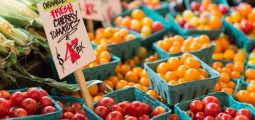Recipe Rescue: How to steer dishes that go awry back on course

What do sesame oil, fresh rosemary and Louisiana hot sauce have in common?
They were part of one of the seminal cooking moments of my lifetime. I was making a stir fry in a brand new wok. The veggies were brightening and I wanted one last splash to add a new flavor. I reached for sesame oil expecting a stopper lid, shook vigorously only to find no such lid. My brilliant stir fry was now swimming in sesame oil with precious little time before dinner. The dish needed something else that had firepower to soften the sesame. I turned to my fridge and found Frank’s Louisiana Hot Sauce and some fresh rosemary from the farmer’s market. A couple splashes of hot sauce and a couple sprigs of rosemary and the sesame oil all of the sudden took a back seat. Low and behold, it actually tasted good, REALLY good.
A mistake became magnificent and it happened on the fly. Sometimes, the end result turns out better than the original intention. Here’s how to embark on the task of recipe rescue.
The three key areas of recipe rescue are preparation, attention and accessibility. The most important stage begins before you even pick up a knife. Reading the recipe before actively starting the cooking process provides ample time to venture to the store to grab that extra item if needed. For specialty dishes, more advanced planning is necessary because specific or seasonal ingredients may not be readily available at your closest grocer.
Take note of what you’re cooking often. Nonperishable ingredients are much easier to have on hand. Checking the regular ads of grocery stores offers prime opportunity to acquire that extra bag of flour, sugar or baking soda. Anytime you’re making a larger amount of meat, seize the opportunity to siphon some stock and freeze it. Home gardening is a chance to save an overabundance of vegetables. Freeze a bag for that last minute need of peppers, onions, carrots and others.
The quality of ingredients on hand can also make a difference. Debbie Akyurek, owner of Savory Spice Shop in Omaha says “if you use a higher quality of cinnamon, salt, pepper, cardamom, and many other base ingredients, you don’t have to use as much of it when making your adjustment. Often times you’re just trying to move the needle a bit, rather than trying to completely overhaul a dish at a moment’s notice”.
The last focus of preparation lies with the organization and arrangement of your kitchen. Nick Evans, owner of the Cooking Site Macheesmo.com, states he does his best cooking when he has everything laid out in front of him and isn’t spending time searching for things in the middle of the process. He adds that “it’s also important for first time recipes to add 15-30 minutes of total time. Being rushed can lead to unnecessary improvisations.”
Now that the kitchen and ingredients are organized, we’ve moved to the attention stage of recipe rescue. The more active and attentive you are with your dish, the more opportunity to make the necessary adjustments in the flow of the cooking. For example, on Thanksgiving this year I attempted a pomegranate molasses for a Brussels sprout salad. I thought I followed the recipe exactly but made one significant mistake. I reduced the juice and sugar at way too high a temperature, resulting in pomegranate hard candy – not syrup. Using physics in reverse I merely waited till the last minute of adding the molasses, reheated the mixture to liquid form and mixed it in to salvage the needed ingredient.
The temperature of one ingredient can be a catalyst for ruining a dish. Stan Santos of simplekitchenseasons.com was working with a brunch dish that required scrambling eggs, a task he rarely does. For the dish “I cooked the eggs on medium low heat instead of low resulting in the eggs cooking more quickly than intended and that threw off timing on everything else”.
Other common problems that can be corrected in the process are: dishes being too dry/too wet, too savory/too sweet, and mixtures not coming together as a recipe or you intended. I surveyed several amateur chefs to learn what their strategies are for overcoming these problems and a few themes arose. For dishes that are too dry: stock, water and oils are you biggest assets. I’ve seen fellow Omahan Hillary Nather-Detisch for more than a decade at the local Farmer’s Markets and organic food stores. She’s always looking for new courses to cook for friends and family. A big part of her versatility comes from one staple ingredient, “I always have chicken stock on hand to help add moisture and flavor (if cooking)”, Nather-Detisch says.
Terrance Hill, an Omaha native, specializes in clean eating with natural ingredients. Hill prefers to make as many of his base ingredients at home. The process taught him that it’s cheaper, healthier, and the supplies last longer in doing so. He shared a couple important techniques he uses for cooking. He adds water or oils to liquefy sauces and gravies and cornstarch or flour if it needs to thicken. Hill also pays close attention to temperature and stirring the additional ingredients in to attain the desired thickness and flavors. “I always struggled with making mayo, Once, I added the olive oil too fast with the egg/vinegar mixture and the two never combined, or created an emulsion. I was able to start a new egg/vinegar mixture. And this time I slowly added the previously ruined recipe a drop at a time to the mixture while whisking briskly. Eventually it formed an emulsion and presto… mayo. It was an awesome feeling”.
Since you’re paying close attention to your dish as it comes together, you’ll have the opportunity to taste it to see how the flavors are evolving. If it’s too sweet; add salt, pepper, chilies or rosemary. If it’s too savory; sugars, fruits and honey could become your friends.
The taste dilemma brings us to our final rescue component; accessibility. In the heat of the kitchen and a culinary deadline coming, time is not your friend. It’s important to have ingredients as you need them, when you need them and where you need them. The vegetables, herbs, spices, oils or dry ingredients need to be ready for immediate introduction into your dish. Savory owner Akyurek offers a few tips: “Chefs may not have time for chopping fresh herbs and spices such as garlic and basil, so having dried ingredients immediately available can provide the needed flavor impact”.
Don’t be afraid to purchase or to pre-toast and store ingredients such as onion, seeds, or nuts. When dishes are already in motion, there may not be time to toast ingredients. It’s at this point that the quality of what you purchase matters, “The better quality of the product you purchase, the quicker and fuller the flavors release into the dish” Akyurek adds.
Let’s make one more step in your rescue – keep records. Take notes of what worked, and incorporate that into future preparations. Julie Berger, a local Omaha amateur chef, grew up baking with her family in Spaulding, Nebraska. Two years ago she discovered a wheat allergy and has been cooking gluten free meals ever since. She’s found initial recipe adjustments become staples in her every day cooking, “I often have to substitute some ingredients, especially gluten free flours. For instance, I didn’t have millet flour on hand for a pizza crust a few weeks ago, so used buckwheat instead and it was still really good. I’ve also found coconut or sorghum flour in meatloaf instead of bread crumbs is actually really good”.
Bruce Moritz and his wife Lisa of Omaha make dining and cooking a big part of their travels and celebratory occasions. One night they were using an Asian themed approach for their multiple course meal. “I thought we had lettuce, spinach, or some kind of greens for a salad,” Bruce said. “We didn’t, so I ended up creating an Asian apple salad (Fuji apple, cilantro, soy sauce, jalapeño, broccoli slaw, red onion, ginger, lemon juice and cracked pepper). It is now one of our favorites.”
Even the best chefs can and will fail. Cooking provides an avenue for both exploration and experimentation. For those who prepare, are attentive, and act quickly, it offers the opportunity for mistakes and missteps to turn into magnificent creations.

Kent Cisar
Kent Cisar searches the local and national scene for unique ingredients and flavors to bring to the table here in Omaha. He'll catch his own fish from Florida, ship farmer's market shrimp from Louisiana, stash jams from the Pacific Northwest, or find the best cut of meat from a Nebraska farmer. Kent believes that regardless of where the it comes from, good food is meant to be shared.
Related Articles
24th Street: The Longest Street In The World
Where’s the buzz that should be surrounding 24th Street? Where’s the “24th Street has a lot to offer”, or the
Omaha’s Largest Pizza Review #6
Food & Spirits Magazine recently hosted Omaha’s 6th Annual Pizza Review at The Waiting Room. As it has been for
Fixin’ for Chicken
I decided to go on a quest for the Best fried chicken on a cold Saturday morning while driving around
No comments
Write a commentOnly registered users can comment.














